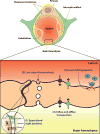Neuronal and vascular interactions
- PMID: 25782970
- PMCID: PMC5729758
- DOI: 10.1146/annurev-neuro-071714-033835
Neuronal and vascular interactions
Abstract
The brain, which represents 2% of body mass but consumes 20% of body energy at rest, has a limited capacity to store energy and is therefore highly dependent on oxygen and glucose supply from the blood stream. Normal functioning of neural circuits thus relies on adequate matching between metabolic needs and blood supply. Moreover, not only does the brain need to be densely vascularized, it also requires a tightly controlled environment free of toxins and pathogens to provide the proper chemical composition for synaptic transmission and neuronal function. In this review, we focus on three major factors that ensure optimal brain perfusion and function: the patterning of vascular networks to efficiently deliver blood and nutrients, the function of the blood-brain barrier to maintain brain homeostasis, and the regulation of cerebral blood flow to adequately couple energy supply to neural function.
Keywords: blood–brain barrier; cerebral blood flow; cerebrovascular patterning; endothelial cells; neurovascular networks; neurovascular unit.
Figures



References
-
- Aird WC. Phenotypic heterogeneity of the endothelium: I. Structure, function, and mechanisms. Circ Res. 2007;100:158–73. - PubMed
-
- Alvarez JI, Dodelet-Devillers A, Kebir H, Ifergan I, Fabre PJ, et al. The Hedgehog pathway promotes blood-brain barrier integrity and CNS immune quiescence. Science. 2011;334:1727–31. - PubMed
-
- Anderson AW, Marois R, Colson ER, Peterson BS, Duncan CC, et al. Neonatal auditory activation detected by functional magnetic resonance imaging. Magnetic resonance imaging. 2001;19:1–5. - PubMed
-
- Argandona EG, Lafuente JV. Effects of dark-rearing on the vascularization of the developmental rat visual cortex. Brain Res. 1996;732:43–51. - PubMed
Publication types
MeSH terms
Grants and funding
LinkOut - more resources
Full Text Sources
Other Literature Sources

